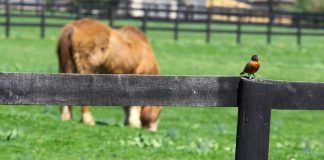Recognizing health problems in your horse is the first step toward treating them. For some problems, early recognition can mean the difference between recovery and disaster. Here’s a glossary of common ailments and horse health terms.
| Abscess (hoof abscess, sole abscess): A pocket of infection in the foot. Read more >>Alfalfa: Abundant in protein and calcium, alfalfa is a good source of forage for young, growing horses and lactating mares. Read more >> |
| Beet Pulp: Beet pulp is a high-fiber roughage source that is easily digested by horses. |
| Choke: An obstruction of the esophagus, usually caused by eating too fast, but may be caused by narrowing of the esophagus due to a previous choke episode or in rare cases, pressure from a tumor. Read more >>Colic: Abdominal pain due to intestinal gas, impaction, torsion (twisting) or other causes. Read more >>Concentrates: Concentrates are grain mixtures formulated specifically for horses as a concentrated source of energy (calories). Read more >>Cushing’s syndrome (hyperadrenocorticism): A disease caused by a benign tumor in the pituitary gland, which controls the entire endocrine system. Read more >> |
| Digestion: The digestive system of a horse works very differently from that of a human. Read more >> |
| Exercise: In general, horses that are properly fed are more likely to be too fat than too thin. Read more >>Eye injuries: Various types of trauma involving the eye and surrounding structures. Read more >> |
| Fiber: Unlike humans, horses are able to extract energy from the fiber in their diet. Read more >>Founder: In severe cases of laminitis, the coffin bone inside the hoof tears away from the hoof wall and rotates downward, causing a permanent need for corrective trimming and shoeing. This is called founder. Read more >> |
| Grazing: Good-quality pasture is a wonderful source of energy, protein, fiber and vitamins. Horses enjoy grazing and are designed to move around, eating grass in a herd situation. In most areas, however, pasture space is limited and careful maintenance is required to keep turnout time healthy and productive. Regularly removing manure helps break the fly and parasite life cycles, while resting fields by rotating horses to other paddocks will allow grass to recover and keep undesirable weeds to a minimum. |
| Hay: When purchasing hay for your horse, assess its freshness; it should not be dusty or smell moldy or musty. Read more >>Heaves, aka chronic obstructive pulmonary disease (COPD) or recurrent airway obstruction (RAO): A chronic allergic respiratory disease triggered by exposure to straw and/or hay, resulting in airway inflammation, mucus production and bronchoconstriction. Read more >>Hives (urticaria): A skin manifestation of an allergic reaction to various triggers, including insect stings/bites, chemicals, medications or, less commonly, ingested or inhaled substances. Read more >> |
| Insulin Resistance: When starches and sugars are consumed, the body releases insulin, a hormone that cues absorption and storage of sugar from the bloodstream. Read more >> |
| Joint Supplements: Arthritis and degenerative joint disease are common problems in performance horses. Read more >> |
| Kentucky Bluegrass: Kentucky bluegrass is a cool-season grass (Poa pratensis) that grows best in spring and fall, and resists trampling and close grazing quite well. Read more >> |
| Lameness: An abnormality of movement due to an injury or infection in one or more legs. Read more >>Laminitis:What it is: Inflammation of the laminae, the structures in the foot that connect the hoof wall to the coffin bone. Read more >> |
| Navicular syndrome: A degenerative condition characterized by progressive damage to the navicular bone, a small bone of the foot, with accompanying damage to the deep digital flexor tendon and other adjacent structures. Read more >> |
| Osteochondritis dissecans: OCD refers to cartilage or cartilage and bone pieces or flaps that develop in the articular surfaces of joints, most commonly the fetlock, hock, and stifle joints. These fragments and flaps occur due to a defect in the developing bone. Read more >> |
| Pedal Osteitis: An inflammatory condition of the coffin bone (also called the pedal bone, distal, or third phalanx, or P3) that results in demineralization of that particular bone. Read more >> |
| Quidding: When a horse only partially chews his food and then allows much of it to drop from his mouth it’s called “quidding.” Most often seen in senior horses or horses that have not had regular dental maintenance. Read more >> |
| Rain rot (dermatophilosis): A skin infection caused by Dermatophilus congolensis, a fungus-like bacteria present on the skin of many horses. Read more >> |
| Scratches, aka pastern dermatitis or “greasy heel”: Inflammation of the skin on the lower legs caused by bacteria (for example, the same organism that causes rain rot), fungal infections, local irritation, external parasites (such as mites), or photosensitization. Read more >>Stocking Up: A common equine term referring to generalized swelling in a horse’s distal limbs. Medically this condition is known as a type of localized edema, or accumulation of fluid in the subcutaneous tissues. Read more >> |
| Thrush: A disease of the hoof’s frog, with an accompanying secondary bacterial infection. Read more >> |
| Uveitis: Inflammation/irritation of the layer of the eye known as the uvea. Read more >> |
| Vaccinations: Vaccinations can save your horse’s life by protecting him from various diseases. Read more >>Vital Signs: Knowing how a healthy horse looks and acts can help you catch illnesses and injuries early. Read more >> |
| Wounds: Lacerations (cuts) and puncture wounds. Read more >> |






